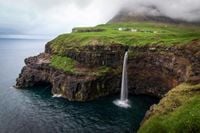The Faroe Islands, a rugged and windswept archipelago in the North Atlantic, have long held a certain mystique for travelers in search of the untamed. Now, as global temperatures rise and the allure of “coolcations” intensifies, these self-governing Danish islands are witnessing a surge in adventurous visitors. Yet, beneath their jaw-dropping beauty lies a stark warning: nature here does not forgive missteps.
September 2025 brought this reality into sharp focus when three tourists vanished over two days near a renowned waterfall that plunges straight into the sea. Their disappearance, as reported by the Associated Press, prompted a local staff member to issue a simple plea: “Be careful. Come back.” It’s a reminder that this landscape, so dramatic it served as the backdrop for James Bond’s final scene in ‘No Time to Die,’ is as perilous as it is picturesque.
The terrain is not for the faint of heart. Crumbling cliffs, sudden gale-force winds, and hillsides so steep that even sheep occasionally tumble define the islands’ wild character. For those prone to vertigo, seasickness, or a fear of confined spaces, the Faroes can be especially daunting. “When you make a mistake here, nature usually wins,” a local food truck vendor told the AP, summing up the ever-present risks that lurk amid the islands’ stunning vistas.
Despite these hazards, the Faroe Islands are experiencing a boom in tourism. Bird-watchers flock to see puffins and other seabirds, while foodies are drawn to unique culinary experiences—think sushi made from locally farmed salmon and newly knitted wool sweaters sold in village shops. The islands’ reputation as a destination for those seeking something different has only grown, with the rise of “coolcations” offering respite from the heat elsewhere in Europe.
Yet, many visitors are unprepared for the Faroes’ unpredictable environment. Locals, who have spent generations navigating mountain passes and rocky shores, possess an innate sense of when to avoid treacherous cliffside trails or how to handle the sudden, dense fogs that can roll in without warning. It’s knowledge that can mean the difference between a memorable adventure and a disaster. The official Visit Faroe Islands website doesn’t mince words, warning: “Ferocious wind can overturn cars, fling bicycles, wheelbarrows — and sheep — or anything else that’s not anchored down.”
To help travelers stay safe, the Landsverk local authority and FaroeIslandsLive offer real-time weather cams, while the tourism office provides detailed advice on safe exploration. Still, accidents happen. People can and do slip from trails into the sea, a risk that’s all too real given the islands’ steep, unguarded paths. Even trails marked as suitable for children may not be, as hiking times and difficulty levels are often estimated by locals accustomed to the terrain.
Infrastructure is adapting to the influx. A growing network of undersea tunnels—including what’s touted as the world’s first undersea roundabout—now links several of the 18 islands, making previously remote areas more accessible. Rugged isolation is giving way to smooth highways, and Airbnb now lists hundreds of accommodations among a population of just over 50,000. But these conveniences come at a price: undersea tunnel fees range from over $15 for a round trip to more than $27 one way, typically settled through rental car companies at the end of a visit. The popular hike to the Kallur lighthouse on Kalsoy Island, a must for many, costs about $30.
Public buses do serve many locations, but timetables are limited, so most visitors opt for rental cars for flexibility. On land, some older tunnels are single lanes with designated passing areas, and certain scenic “buttercup” routes are also single-lane roads. Guardrails are sometimes absent, and in places like the road leaving Tjornuvik, a traffic signal limits travel to one direction at a time along a battered guardrail above the sea. Residents have noted that tourists often struggle with reversing on these narrow stretches.
As the islands open up, authorities are keen to balance tourism with preservation. In 2019, the Faroe Islands introduced a yearly “closed for maintenance” program, inviting volunteers from around the world to help with anti-erosion projects, path upkeep, and other conservation efforts. The national museum has since launched additional initiatives to protect land and biodiversity. More recently, the tourism office rolled out self-navigating tours that guide visitors away from the most heavily trafficked spots to lesser-known gems—like a seaside village famed for its music festival, a tiny botanical garden, a fjord-side memorial to a deadly shipwreck, and a small forest plantation on these otherwise treeless islands.
For those who love the outdoors, the possibilities seem endless: cycling, fishing, exploring an emerging sauna scene, and sampling local cuisine. Summer boat tours might feature music concerts inside sea caves or puffin-watching excursions. Even as winters remain fierce—locals recall a storm two years ago that ripped the roof off a house in Sydradalur—interest in the islands is extending the tourist season into October.
But the Faroe Islands are not without their quirks and reminders to tread lightly. Villages in the wilder northern regions may have only a handful of residents. Outside the capital, Torshavn, tourist amenities are sparse, though places like Gjogv offer a welcoming guesthouse and café. English is widely spoken, but visitors are advised to heed local guidance—even the more pointed variety. As one sign at the church in Saksun put it: “Due to unmannerly behaviour and lack of quietness on the graves, the cemetery is closed.” Another at the Kalsoy ferry stop warns: “Do not wash your shoes in the sink!”
Sheep, a constant presence, are both a charm and a hazard. Drivers are cautioned to stay alert—if you hit a sheep, the police should be called. Drone use is restricted, and the Visit Faroe Islands site offers details on where and when they’re permitted. Cash is rarely needed; most transactions are handled by card or phone. Food can be expensive, largely because much of it is imported.
Finding equilibrium between welcoming visitors and preserving the islands’ fragile beauty is an ongoing challenge. The Faroe Islands’ fishing-dominated economy relies on cordial ties with countries like Russia and China, and global visibility is growing thanks to a new co-chairmanship of the Arctic Council and even a remarkable run toward their first football World Cup. For now, the islands remain a place where adventure and caution must go hand in hand—a lesson every traveler should take to heart.






